13 Colorful Killifish Species with Images and Quick Care Stats
Don’t let the name fool you—Killifish aren’t out to take down your tank! These little gems are some of the most vibrant, unique fish you can add to a tropical setup, perfect for beginners and intermediate aquarists alike. Some sport subtle hues, while others strut bold patterns and personalities that’ll steal the show. What’s the catch? They’re mostly easy to care for, yet tricky enough to keep things interesting. Plus, they’re popping up in pet stores everywhere, so finding your next tank star is easier than ever. Ready to meet 13 of the flashiest Killifish around? Let’s dive in!
- Geography of Killifish
- 13 Colorful Killifish Species
- Killifish Lifecycle
- Caring for Killifish
- Conclusion
Geography of Killifish
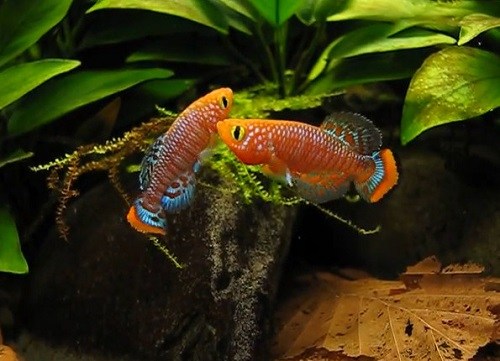
Killifish hail from the Cyprinodontiformes order and are sprinkled across freshwater spots on almost every continent—over 1,200 species strong! Their dazzling colors scream “tropical,” and yeah, many thrive in warm climates, but here’s the kicker: some hang out in cooler, less steamy waters too. In the wild, they’re masters of temporary homes—think seasonal pools, swamps, creeks, even brackish estuaries or shallow streams. Wherever they are, thick vegetation is their jam, surrounded by aquatic plants and even some land-loving greenery. This guide spotlights 13 popular types, dishing out their vibes, tank needs, and must-know tips to pick the perfect one for you.
13 Colorful Killifish Species
1. Clown Killifish
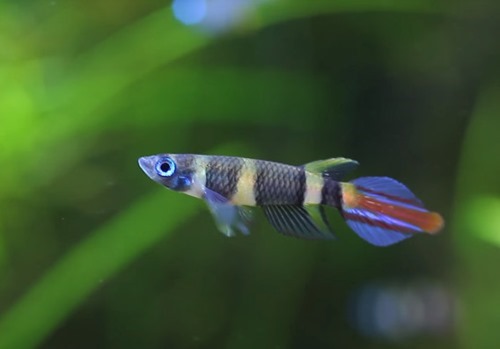
- Scientific name: Epiplatys annulatus
- Care level: Moderate
- Temperament: Peaceful
- Lifespan: Up to 5 years
- Size: 1.2–1.4 inches
- Tank size: 5–10 gallons
- Water: 69–78°F, pH 4.0–7.0
- Diet: Carnivore
Clown Killifish are the tiny clowns of the tank—bold black stripes, splashy blue-and-red tails, and a vibe that echoes fancy saltwater fish. At just over an inch, they’re a cinch to care for and thrive in nano setups as small as 5-10 gallons. Peaceful and social, they love a tank decked out with plants and rocks—top-dwellers that play nice with bottom buddies or fellow Killifish. Keep their space cozy and lush, and they’ll reward you with lively antics for up to five years!
2. Red-Striped Killifish
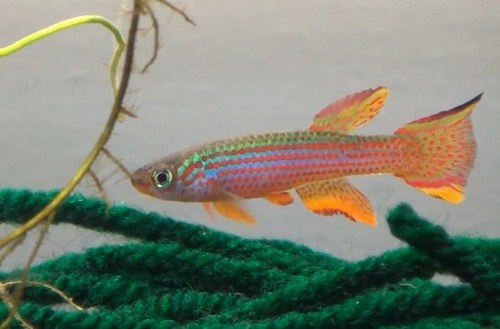
- Scientific name: Aphyosemion striatum
- Care level: Easy
- Temperament: Peaceful
- Lifespan: 3–5 years
- Size: 2 inches
- Tank size: 10 gallons
- Water: 68–73°F, pH 6.5–7.5
- Diet: Carnivore
Red-Striped Killifish are beginner-friendly gems—2 inches of chill with zigzag stripes in blue and orange, dotted with red. A 10-gallon tank suits them fine, especially if it’s planted to mimic their wild haunts. They’re jumpers, so slap on a tight lid, and keep the water soft and slightly acidic with dim lighting. Their unique, brilliant look makes them a no-brainer for anyone wanting a splash of color without the fuss.
3. Magnificus Killifish
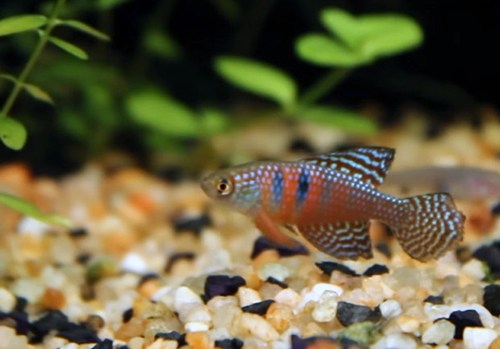
- Scientific name: Hypsolebias magnificus
- Care level: Easy
- Temperament: Peaceful
- Lifespan: 2 years
- Size: 1 inch
- Tank size: 5–10 gallons
- Water: 72–75°F, pH 5.0–7.2
- Diet: Carnivore
Magnificus Killifish live up to their name—bright blue with multicolored stripes and shiny dots that dazzle. At a mere inch, they’re perfect for nano tanks (5-10 gallons) and super easy for newbies. Peaceful and short-lived at two years, they love soft, warm water with heaps of plant cover—think driftwood and floaters. A low-stress setup keeps these tiny show-offs happy and glowing!
4. Chocolate Lyretail
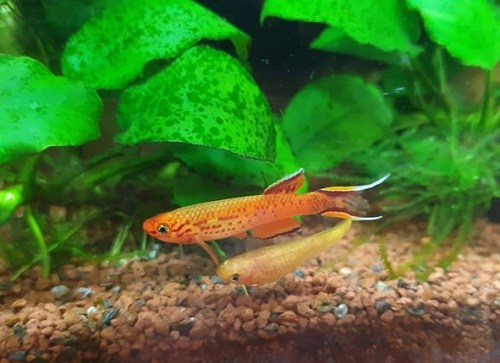
- Scientific name: Aphyosemion australe
- Care level: Easy
- Temperament: Peaceful
- Lifespan: 2 years
- Size: 2–3 inches
- Tank size: 10 gallons
- Water: 70–75°F, pH 6.0–6.5
- Diet: Carnivore
Chocolate Lyretail Killifish bring a warm twist—vibrant red-orange (or softer brown) with lyre-shaped tails on the males. Growing to 3 inches, they’re comfy in a 10-gallon tank but wouldn’t mind a bit more room. Peaceful and adaptable, they shine in warm, acidic water with tons of plants. Keep their world calm, and these two-year wonders will strut their stuff in style!
5. Blue Lyretail
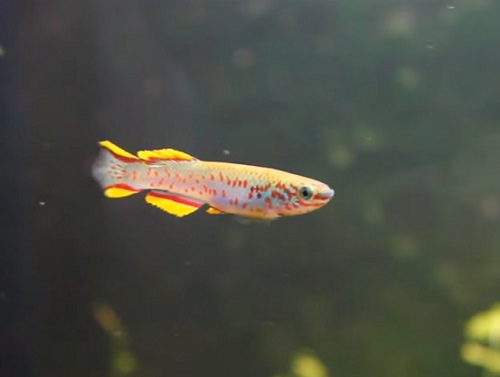
- Scientific name: Fundulopanchax gardneri
- Care level: Moderate
- Temperament: Semi-aggressive
- Lifespan: 3 years
- Size: 2.5 inches
- Tank size: 10 gallons
- Water: 68–79°F, pH 6.0–7.5
- Diet: Omnivore
Blue Lyretail Killifish are the feisty cousins—2.5 inches of blue-green brilliance with yellow lyre tails on the males. They’re moderately tricky thanks to a semi-aggressive streak; too many males in a 10-gallon tank spells trouble—stick to one per four females. Always hungry, they demand a rich diet (live, frozen, flakes) to stay chill and colorful over their three-year run.
6. Two Stripe Lyretail
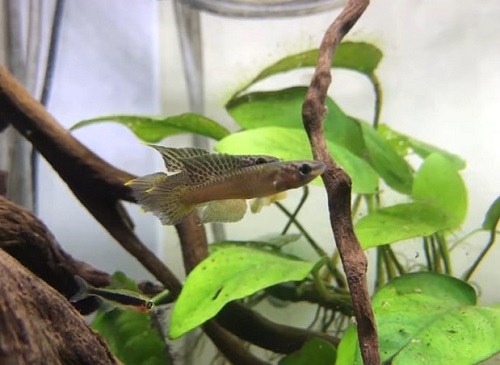
- Scientific name: Aphyosemion bivittatum
- Care level: Easy
- Temperament: Peaceful
- Lifespan: 3–5 years
- Size: 2 inches
- Tank size: 10 gallons
- Water: 70–79°F, pH 5.5–7.0
- Diet: Carnivore
Two Stripe Lyretails are beginner darlings—2 inches with red stripes, green-blue-orange fins, and a peaceful vibe. They live up to five years in a 10-gallon tank, loving warm, slightly acidic water with floating plants and bogwood. Carnivorous but not fish-hunters, they might tussle with other top-dwellers over food—spread the love at feeding time, and they’ll thrive!
7. Argentine Pearlfish
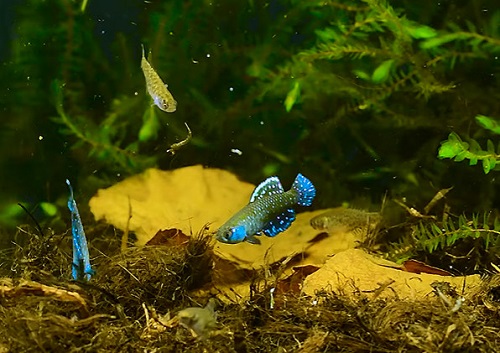
- Scientific name: Austrolebias bellottii
- Care level: Moderate
- Temperament: Semi-aggressive
- Lifespan: 8 months
- Size: 2.75 inches
- Tank size: 15 gallons
- Water: 65–72°F, pH 6.5–7.0
- Diet: Carnivore
Argentine Pearlfish are short-lived stunners—dark blue with pearly teardrop dots, hitting 2.75 inches in just eight months. A 15-gallon tank suits them, but they’re a breeding challenge with a semi-aggressive edge—one male per five females keeps the peace. They need pristine water, a thin substrate, and lots of plants. A fun pick for those ready to dive into Killifish parenting!
8. Kisaki Killifish
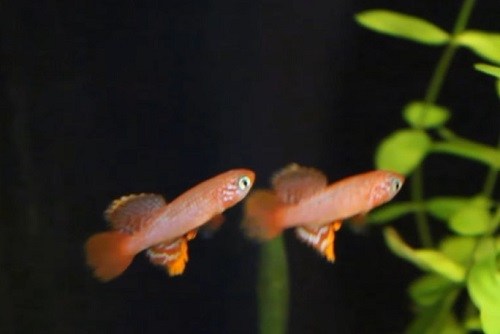
- Scientific name: Nothobranchius flammicomantis
- Care level: Easy
- Temperament: Peaceful
- Lifespan: 1–2 years
- Size: 2.5 inches
- Tank size: 10 gallons
- Water: 70–80°F, pH 6.5–7.0
- Diet: Carnivore
Kisaki Killifish are fiery little beauties—bright red with blue eyes, growing to 2.5 inches in a 10-gallon tank. Easy and peaceful, they live one to two years and love warm water with a sandy bottom for burrowing. Too many males spark fights, so keep it one guy to a few gals—or go bigger (20 gallons) if you want a crew. A striking, low-fuss pick!
9. American Flagfish
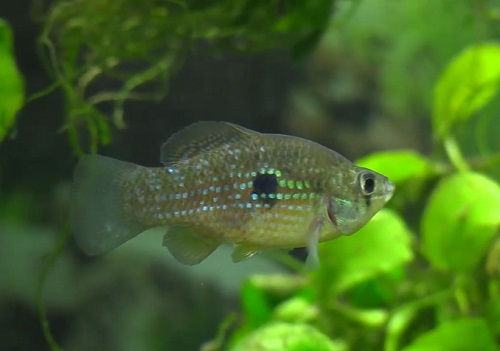
- Scientific name: Jordanella floridae
- Care level: Moderate
- Temperament: Semi-aggressive
- Lifespan: 1–2 years
- Size: 2.6 inches
- Tank size: 15 gallons
- Water: 59–70°F, pH 7.0–8.0
- Diet: Omnivore
American Flagfish wave their colors proud—red, white, and blue stripes straight from Florida’s swamps. At 2.6 inches in a 15-gallon tank, they’re moderately tricky, turning feisty during mating season. Omnivorous and plant-nibbling, they live one to two years and play nice with similar-sized pals outside breeding time. A patriotic twist for collectors!
10. Blue Gularis
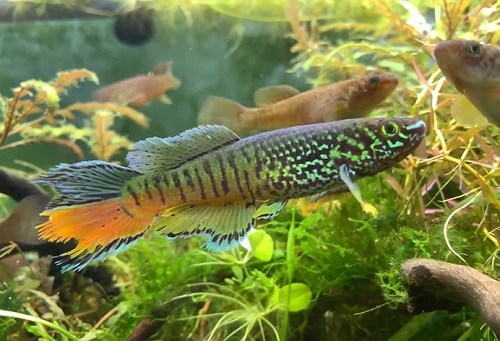
- Scientific name: Fundulopanchax sjoestedti
- Care level: Moderate
- Temperament: Semi-aggressive
- Lifespan: 5 years
- Size: 3.5–5 inches
- Tank size: 20 gallons
- Water: 73–79°F, pH 6.0–7.0
- Diet: Carnivore
Blue Gularis are the big shots—up to 5 inches with blue-green fins, needing a 20-gallon tank. Moderately tough, they live five years and demand a swampy setup: dark substrate, heavy plants, low light, and pristine water. Semi-aggressive and food-dominant, they’re best with top-feeders to avoid scuffles. A bold, beautiful challenge!
11. Redtail Notho
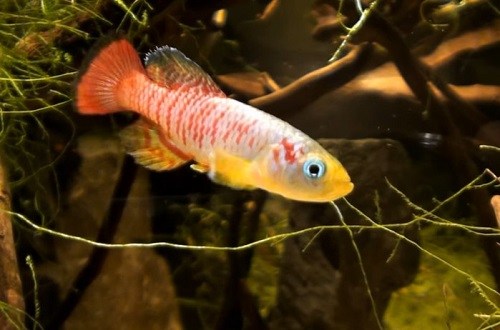
- Scientific name: Nothobranchius guentheri
- Care level: Easy
- Temperament: Peaceful
- Lifespan: 1–2 years
- Size: 2.5 inches
- Tank size: 10 gallons
- Water: 70–80°F, pH 6.0–6.5
- Diet: Carnivore
Redtail Nothos are fan favorites—2.5 inches of red-and-blue flair in a 10-gallon tank. Easy and peaceful, they live one to two years and adapt like champs to warm, clean water. A crowd-pleaser with saltwater vibes, they’re chill unless too many males cramp their style—keep it spacious if you’re doubling up!
12. Blue Notho
- Scientific name: Nothobranchius guentheri
- Care level: Easy
- Temperament: Peaceful
- Lifespan: 1–2 years
- Size: 2.5 inches
- Tank size: 10 gallons
- Water: 70–80°F, pH 6.0–6.5
- Diet: Carnivore
Blue Nothos flip the script—orange bodies with metallic blue fins and tails, kin to the Redtail Notho. At 2.5 inches in a 10-gallon tank, they’re easygoing, living one to two years in warm, dim setups with leafy plants. Beginners love their adaptability and community-friendly nature—a dazzling, no-drama pick!
13. Golden Wonder Panchax
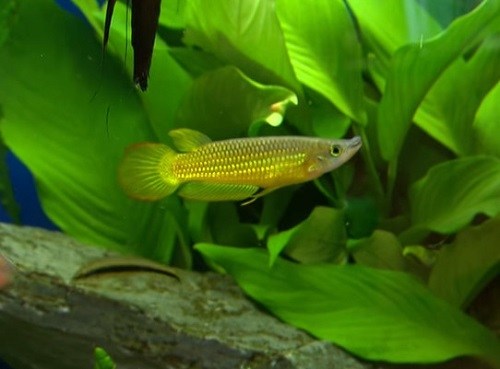
- Scientific name: Aplocheilus lineatus
- Care level: Easy
- Temperament: Semi-aggressive
- Lifespan: 4 years
- Size: 3.9 inches
- Tank size: 20 gallons
- Water: 72–75°F, pH 6.0–6.5
- Diet: Carnivore
Golden Wonder Panchax are the golden giants—nearly 4 inches of sunny brilliance in a 20-gallon tank. Living up to four years, they’re easy but semi-aggressive, hunting smaller fish if crowded. Warm, slow water keeps them happy, and solo or small groups (less than four) curb their feisty side. A standout for a roomy setup!
Killifish Lifecycle
Killifish have a wild card up their sleeve—their lifecycle. Some species live less than a year, adapted to drying riverbeds and ponds that flood again with rain. Adults perish when waters vanish, but their eggs wait it out, hatching when the wet returns. In tanks, they stretch beyond that—many hit five years! Breeding them? Mimic nature with a dry egg phase for some types. It’s a quirky trait that makes them extra rewarding to keep.
Caring for Killifish
Small tanks (10 gallons) work for most Killifish, but here’s the twist: tiny setups need more TLC than bigger ones. Newbies might vibe better with 20-60 gallons—less fuss, more forgiveness. Multiple males? Go 20 gallons minimum to dodge turf wars. These carnivores crave live or frozen goodies—bloodworms, brine shrimp, daphnia—mixed with flakes for balance. Dim lights, lush plants, and hiding spots mimic their wild digs, keeping stress low. Oh, and lock that lid—they’re jumpers! They gel with tankmates like Neon Tetras, Dwarf Cichlids, Gouramis, and Livebearers—just watch male-heavy mixes.
Conclusion
From the Clown’s stripes to the Golden Wonder’s glow, these 13 Killifish prove small fish can pack big pizzazz. Peaceful, vibrant, and beginner-friendly, they’re a joy for any tank. Before you jump in, remember: limit males to avoid squabbles, aim for warm, soft water with lots of décor, and give them space to shine—10 gallons is fine, but more is merrier. With these tips and stats, you’re set to bring some Killifish magic home. Which one’s your pick?

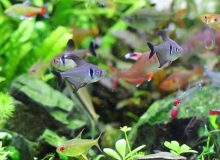
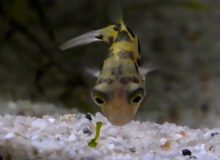
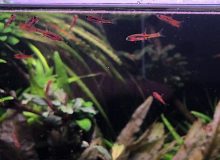
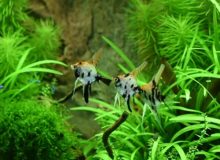
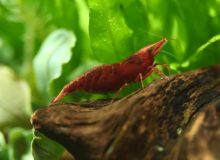
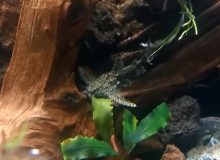
Leave a Reply